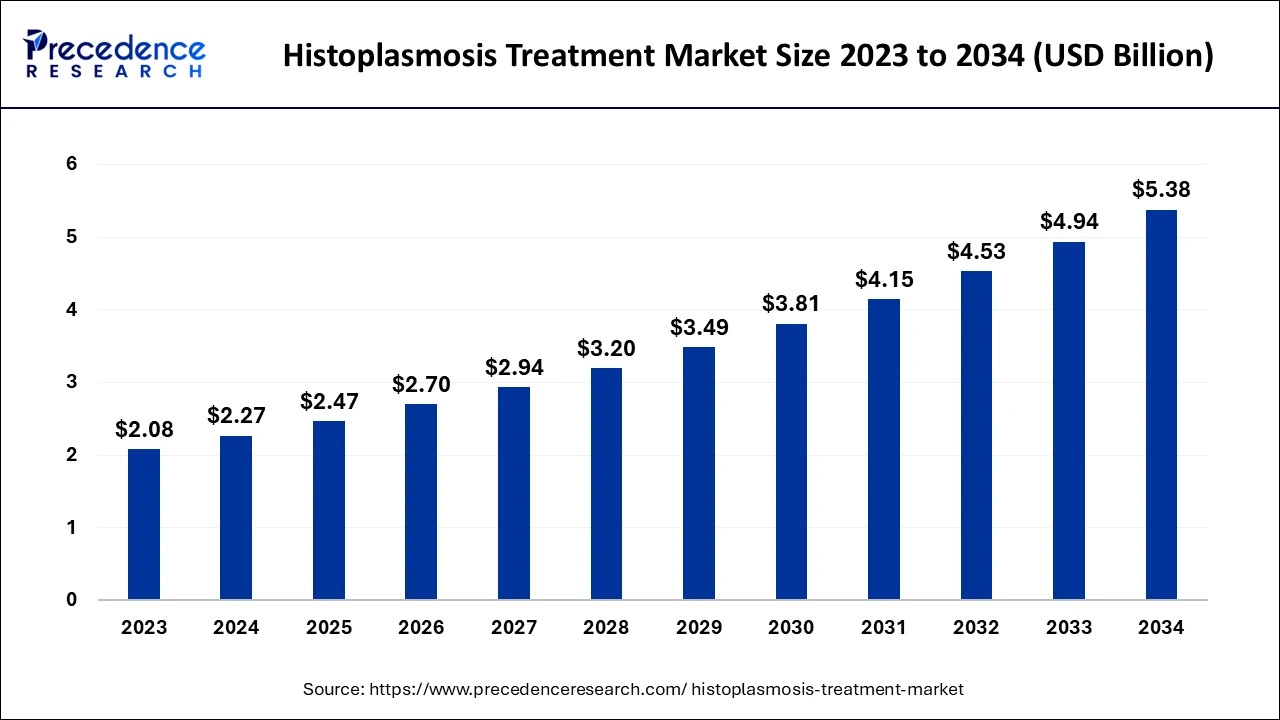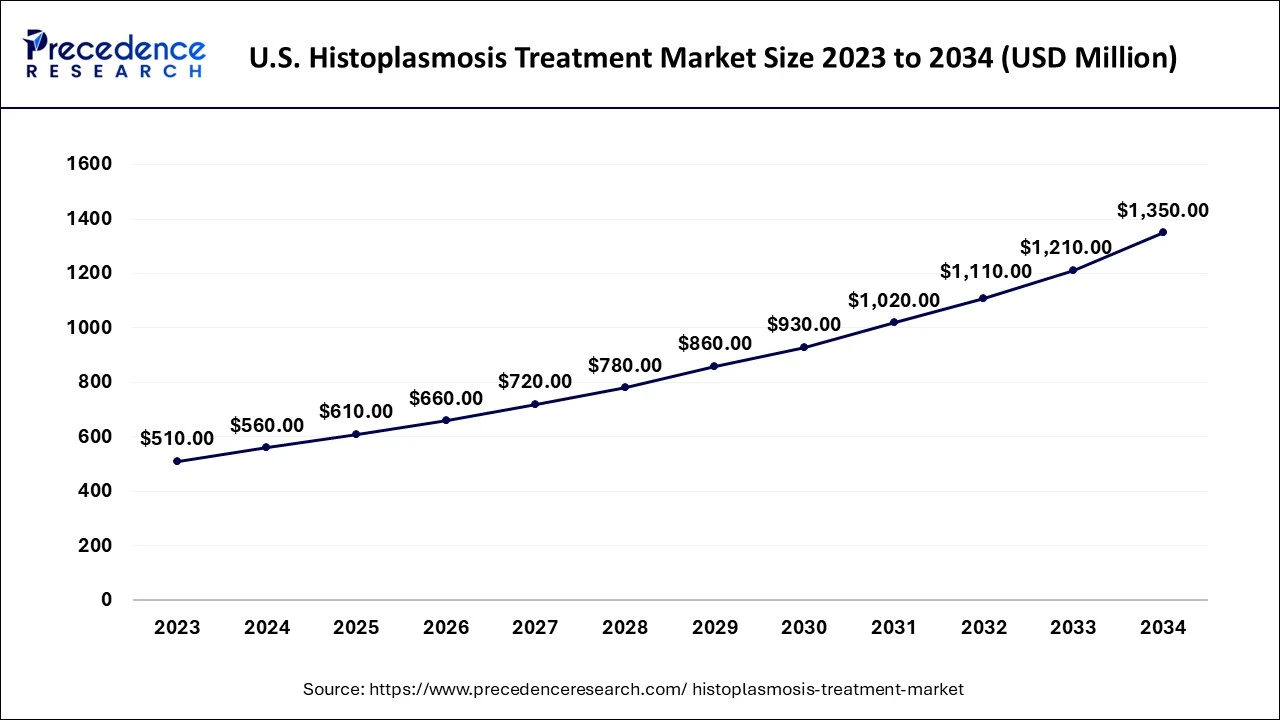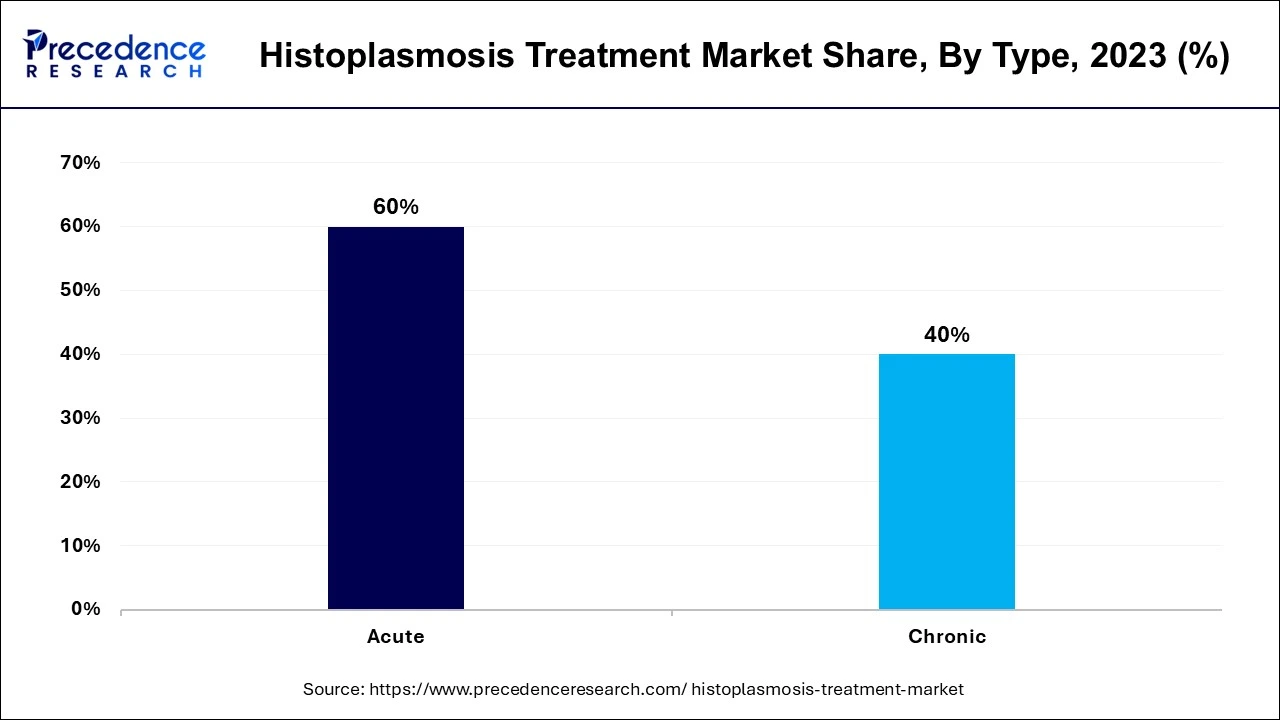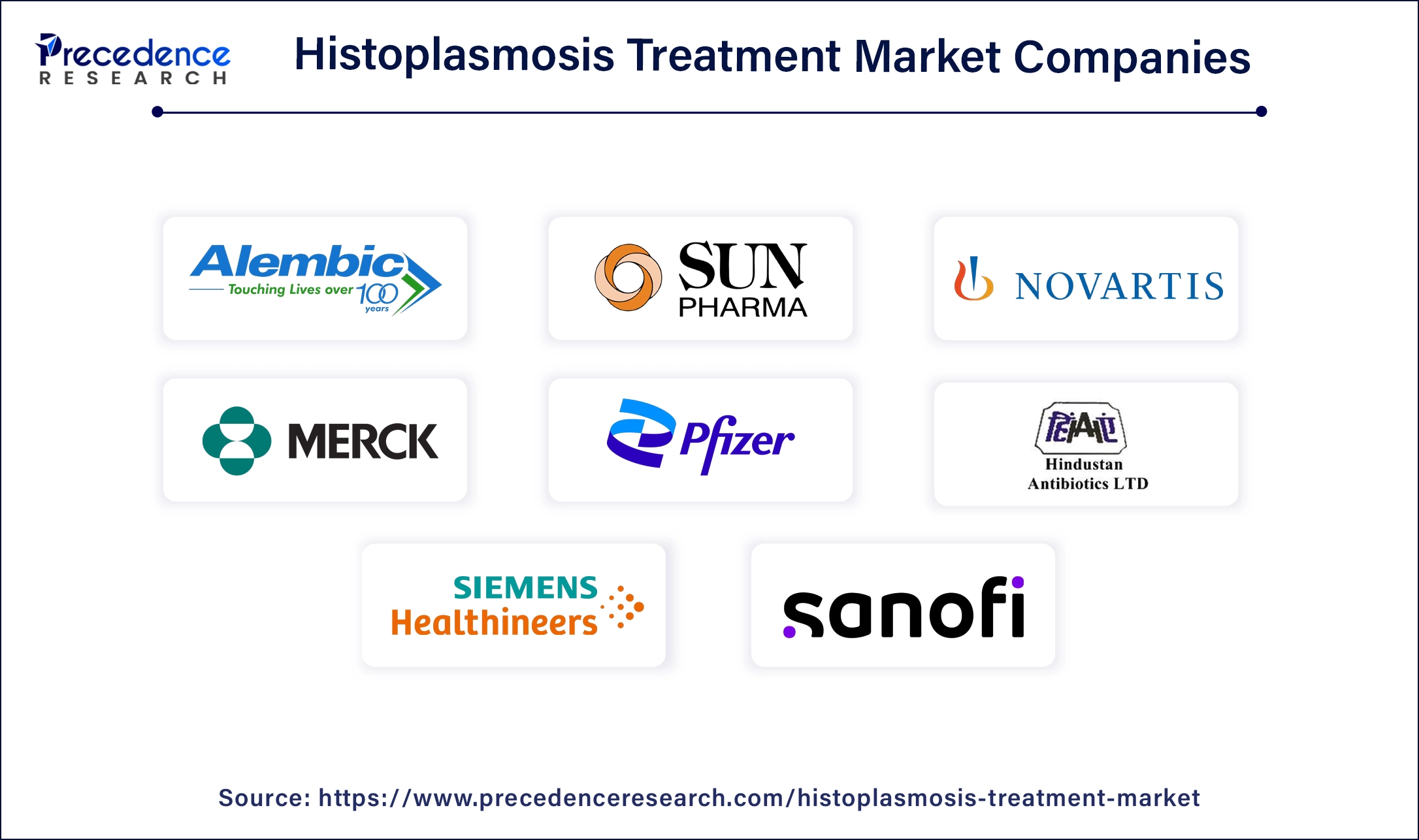January 2025
The global histoplasmosis treatment market size is calculated at USD 2.27 billion in 2024, grew to USD 2.47 billion in 2025 and is projected to reach around USD 5.38 billion by 2034. The market is expanding at a CAGR of 9.03% between 2024 and 2034. The North America histoplasmosis treatment market size is calculated at USD 790 million in 2024 and is expected to grow at a CAGR of 9.25% during the forecast year.
The global histoplasmosis treatment market size accounted for USD 2.27 billion in 2024 and is projected to reach around USD 5.38 billion by 2034, growing at a CAGR of 9.25% from 2024 to 2034. The histoplasmosis treatment market is driven by the rising prevalence of histoplasmosis.

The U.S. histoplasmosis treatment market size is exhibited at USD 560 million in 2024 and is projected to be worth around USD 1,350 million by 2034, growing at a CAGR of 9.03% from 2024 to 2034.

North America dominated histoplasmosis treatment market in 2023. With easy access to medical facilities and specialists, North America, particularly the United States and Canada, has a strong healthcare system. As a result, histoplasmosis may be diagnosed and treated effectively, and there is a steady need for antifungal medications and other forms of treatment. Certain at-risk groups are disproportionately affected by histoplasmosis, such as veterans who might have been exposed while serving in endemic regions. Specialized treatment programs for certain populations have resulted from this, which has increased market demand.
Asia-Pacific is observed to be the fastest growing in the histoplasmosis treatment market during the forecast period. The need for histoplasmosis treatment is increasing as a result of the growth of populations with compromised immune systems, such as those suffering from HIV/AIDS or those receiving immunosuppressive therapies. The Asia-Pacific governments' growing emphasis on infectious diseases and healthcare supports the need for improved diagnostic methods and therapies for illnesses like histoplasmosis.
Rapid urbanization increases exposure to environmental factors that promote the spread of fungal spores, which raises the risk of infection, especially in nations like India. The prevalence of histoplasmosis is anticipated to increase as more people are exposed to polluted settings.
Histoplasmosis is more common in populations with compromised immune systems, such as those with HIV/AIDS, cancer patients receiving chemotherapy, or people using immunosuppressive drugs. The need for more dependable and easily accessible medicines is fueled by the rising number of immunocompromised individuals. The market is growing due to increased investment in healthcare infrastructure, mainly in emerging markets. More people may seek diagnosis and treatment thanks to improved access to healthcare, which raises the need for antifungal drugs.
Cases of histoplasmosis are being recorded outside the traditional endemic regions due to increased international travel and the effects of climate change on fungal habitats. Since health systems in non-endemic areas also need to prepare for the disease's diagnosis and treatment, this expands the potential market for therapies.
How is AI helping Histoplasmosis Treatment Market growth?
Histoplasmosis lesions are different from other respiratory diseases such as lung cancer or tuberculosis by AI-powered imaging technologies. By increasing diagnostic imaging's specificity, these instruments help physicians detect histoplasmosis more precisely and prevent misinterpretation, which results in more specialized treatment. By assisting in selecting qualified participants, tracking their progress, and more effectively analyzing trial data, artificial intelligence is improving clinical trials for novel treatments for histoplasmosis. This guarantees that the tested therapies will probably benefit the appropriate patient populations and expedites the development of novel medications.
| Report Coverage | Details |
| Market Size by 2034 | USD 5.38 Billion |
| Market Size in 2024 | USD 2.27 Billion |
| Market Size in 2025 | USD 2.47 Billion |
| Market Growth Rate from 2024 to 2034 | CAGR of 9.03% |
| Largest Market | North America |
| Base Year | 2023 |
| Forecast Period | 2024 to 2034 |
| Segments Covered | Type, Diagnosis, Drug Type, Route of Administration, and Regions |
| Regions Covered | North America, Europe, Asia-Pacific, Latin America and Middle East, & Africa |
Increasing incidence of histoplasmosis
Better diagnosis rates have resulted from a noticeable rise in healthcare professionals' knowledge of histoplasmosis. Early and precise detection has been made possible by improved diagnostic procedures such as molecular approaches and antigen testing. There has also been an increase in public health efforts to inform people about the risks of histoplasmosis and how to avoid it. This prevention-focused approach indirectly supports the treatment market by motivating at-risk groups to seek treatment promptly.
Regulatory Hurdles
To prove the safety and effectiveness of novel treatments, regulatory agencies such as the US Food and Drug Administration (FDA) need a lot of clinical data. It may take years for a medicine to be approved, making this a laborious procedure. There are fewer therapy options for histoplasmosis because it is frequently regarded as an uncommon disease. Because of this niche position, regulatory agencies may be more stringent in their examination because the prospective market size may not warrant the cost necessary to comply.
Advancements in diagnostic techniques
Researchers can better comprehend the pathophysiology and course of histoplasmosis due to improvements in diagnostics. This information can spur the development of novel therapeutic approaches, resulting in antifungal medications that are less harmful and more effective. Advanced diagnostics can be used to remotely guide treatment as telemedicine becomes more popular. Increased patient involvement and adherence to treatment plans may result from this tendency, boosting market expansion.
The acute segment dominated the histoplasmosis treatment market in 2023. Flu-like symptoms including fever, coughing, and chest pain are common signs of acute histoplasmosis. They may go away on their own in mild instances as more healthcare systems in endemic regions implement routine screenings and awareness campaigns about fungal infections. The acute segment benefits from early intervention, which raises demand for related therapies. However, more severe acute cases, especially in immunocompromised individuals such as those with HIV/AIDS, require prompt medical intervention.

The chronic segment shows a notable growth in the histoplasmosis treatment market during the forecast period. Older people are particularly vulnerable to chronic histoplasmosis because chronic conditions like COPD and emphysema are becoming more prevalent as populations in many areas age. Long-term antifungal treatment for chronic histoplasmosis frequently lasts months or even years. Market expansion is fueled by the higher pharmaceutical sales that result from this protracted treatment. The expansion of the chronic sector is anticipated to be driven by heightened awareness of the hazards of chronic histoplasmosis among patients and healthcare professionals in endemic locations, particularly in populations with underlying lung problems.
The chest CT scan segment dominated the histoplasmosis treatment market in 2023. Due to their greater sensitivity than conventional chest X-rays, chest CT scans are crucial for identifying lung abnormalities linked to histoplasmosis, even in its early stages. This is particularly crucial for patients who conventional imaging methods may overlook due to moderate or silent illnesses. Its technological advancements have also decreased radiation exposure, making it safer to use repeatedly. Patients who need constant monitoring, including those with chronic or recurring histoplasmosis, can significantly benefit from this.
The bronchoscopy segment is observed to be the fastest growing in the histoplasmosis treatment market during the forecast period. A minimally invasive technique called bronchoscopy makes it possible to see the respiratory system up close, including the lungs and bronchi. Bronchoscopy is particularly helpful in histoplasmosis for acquiring lung fluid or tissue samples for additional laboratory investigation (e.g., biopsy or culture). In certain areas, healthcare providers are encouraged to employ these latest methods by advantageous payment schemes for diagnostic procedures, such as bronchoscopies. Payment for bronchoscopy operations will probably keep encouraging its use as more insurance companies and healthcare systems realize how crucial an early and precise diagnosis is to lowering overall treatment costs and enhancing patient outcomes.
The amphotericin B segment dominated the histoplasmosis treatment market in 2023. Since their immune systems are less able to control the infection, people with impaired immune systems are far more likely to get severe histoplasmosis. In these populations, the high potency of amphotericin B is crucial. The need for this medication to treat histoplasmosis is still high as the number of patients receiving immunosuppressive treatments and HIV/AIDS patients rises.
The oral segment dominated the histoplasmosis treatment market in 2023. Oral drugs are less costly than intravenous therapies when considering healthcare costs. IV drug administration comes at a significantly higher expense, including more medical supplies, nursing care, and hospital stays. Oral antifungal therapies have supremacy over the market because they drastically lower these expenses, making them a more cost-effective choice for both patients and healthcare professionals.

Segments Covered in the Report
By Type
By Diagnosis
By Drug Type
By Route of Administration
By Geography
For inquiries regarding discounts, bulk purchases, or customization requests, please contact us at sales@precedenceresearch.com
No cookie-cutter, only authentic analysis – take the 1st step to become a Precedence Research client
January 2025
May 2024
February 2025
September 2024